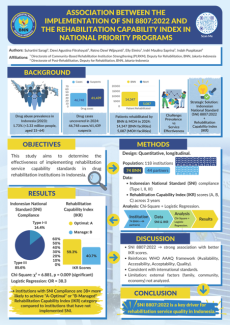ASSOCIATION BETWEEN THE IMPLEMENTATION OF SNI 8807:2022 AND THE REHABILITATION CAPABILITY INDEX IN NATIONAL PRIORITY PROGRAMS

Background:
In 2023, the prevalence of drug abuse in Indonesia among the population aged 15–64 years reached 1.73%, equivalent to 3.33 million people. This problem has prompted The National Narcotics Board (BNN) as a government agency which is responsible for preventing and combating drug abuse and illicit trafficking to improve the quality of rehabilitation services. One of the initiatives undertaken is the implementation of the Indonesian National Standard (SNI) 8807:2022 and the use of the Rehabilitation Capability Index (IKR) as a tool to evaluate service quality.
Objective:
This study aims to determine the effectiveness of implementing rehabilitation service capability standards in drug rehabilitation institutions in Indonesia.
Method:
This study employs a quantitative approach using the Chi-Square analysis method. The sample consists of 74 rehabilitation institutions operated by the National Narcotics Board (BNN) and 44 partner institutions affiliated with BNN. Effectiveness is analyzed through the relationship between the implementation of SNI 8807:2022 and the IKR scores of rehabilitation service providers.
Results:
The analysis revealed a statistically significant association between the implementation of SNI 8807:2022 and IKR scores (Asymp. Sig. = 0.009, p < 0.05). This finding was further supported by logistic regression analysis, which indicated that institutions adhering to the SNI standard were 38 times more likely to achieve optimal IKR categories (OR = 38.333, p < 0.001).
Conclusion:
The implementation of SNI 8807:2022-based rehabilitation service standards is significantly associated with improved IKR outcomes, underscoring the importance of standard compliance in enhancing service quality. However, this study did not examine external factors such as family support, social environment, or patients’ economic conditions post-rehabilitation, which may also play crucial roles. Future research employing multidimensional and longitudinal designs is recommended to better understand the contribution of these factors to the long-term effectiveness of rehabilitation services.
Keywords: drug abuse, rehabilitation services, SNI 8807:2022, Rehabilitation Capability Index (IKR), service quality, BNN
